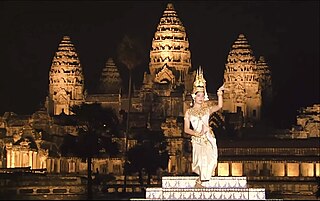
Throughout Cambodia's long history, religion has been a major source of cultural inspiration. Over nearly two millennia, Cambodians have developed a unique Cambodian culture and belief system from the syncreticism of indigenous animistic beliefs and the Indian religions of Buddhism and Hinduism. Cambodia's unparalleled achievements in art, architectures, music, and dance from the 9th and 14th century have had a great influence on many neighboring kingdoms, namely Thailand and Laos. The effect of Khmer culture can still be seen today in those countries, as they share many close characteristics with current-day Cambodia.

Battambang is the capital of Battambang Province and the third largest city in Cambodia.

Cinema in Cambodia began in the 1950s, and many films were being screened in theaters throughout the country by the 1960s, which are regarded as the "golden age". After a near-disappearance during the Khmer Rouge regime, competition from video and television has meant that the Cambodian film industry is a small one.

Ganga is the personification of the river Ganges, who is worshipped by Hindus as the goddess of purification and forgiveness. Known by many names, Ganga is often depicted as a fair, beautiful woman, riding a divine crocodile-like creature called the makara.

Preap Sovath is an iconic and talented singer of the modern Cambodian music industry. His career spans approximately thirty years, and he continues to be one of the most well-known artists in Cambodia, which has inspired many young singers to follow in his footsteps. Aside from being a talented singer, he is also a talented actor; he appeared as a main actor in the well-known movie The Crocodile **. Being considered a legend in the Cambodian modern music industry, he had been chosen to be an audition judge on international TV programs such as Season 1 of Cambodian Idol, Season 1 of Cambodia's Got Talent, and The Voice Kid Cambodia Seasons 1 and 2. With his fame and tireless social work, he continued to represent Cambodia on the international stage and received the prestigious honorary title of Oknha via royal decree in 2022.

Dy Saveth is a Cambodian actress and first Miss Cambodia (1959) often referred to as the "actress of tears". She is "one of the most beloved actresses from the 1960s era of Cambodian film".

The Snake King's Child is a 2001 Cambodian-Thai horror film directed by Fai Sam Ang, based on a Cambodian myth about the half-human daughter of a snake god. It was produced as a sequel to the 1970 movie The Snake King's Wife. It is the first full-length feature film for cinema to be produced in Cambodia since before the Khmer Rouge era. The special effect of the lead character's head being full of writhing snakes was achieved by gluing live snakes to a cap worn by the actress.

Tum Teav is a mid-19th century Cambodian romantic tragedy folk tale. It is originally based on a poem and is considered the "Cambodian Romeo and Juliet" and has been a compulsory part of the Cambodian secondary national curriculum since the 1950s.

Tum Teav is a 2003 Romance-tragedy Cambodian film portraying the tragedy of the star-crossed lovers Tum and Teav.

The legend of The Twelve Sisters or The Twelve Ladies, known as Nang Sip Song (นางสิบสอง) or as Phra Rot Meri (พระรถเมรี) in Thai and រឿងភ្នំនាងកង្រី Puthisen Neang KongRei in Cambodia, is a Southeast Asian folktale, and also an apocryphal Jātaka Tale, the Rathasena Jātaka of the Paññāsa Jātaka collection. It is one of the stories of the previous lives of Buddha in which Rathasena, the son of one of the twelve women, is the bodhisattva.
Tep Rindaro is a Cambodian actor and singer. He started acting in 1987. With his career spanning more over 30 years, he is one of the longest starring actors in Cambodia since the fall of the Khmer Rouge in 1979.

Chompa Toung, also known in English as Crocodile Man 2, is a 1969 fantasy Cambodian horror film. It is the sequel to the 1967 film Crocodile Man. It is loosely based on one of the Royal Poems written by Khmer King Ang Duong (1796–1860).
Horror films in Cambodia, first popular in the 1970s, have received renewed attention in Cambodian film making since the resurgence of the local industry in 2003. Horror is one of three popular genres into which most Cambodian films can be loosely grouped, the other two being period pieces and melodrama/romantic drama. The fledgling Cambodian industry of the mid 2000s looked to capitalize on the world-wide popularity of Japanese horror films which have heavily influenced Cambodian horror films. Common themes are ghost or spirit hauntings, possession, folk mythology and revenge by supernatural means. The storytelling takes a slower pace than Western horror and relies on suspense, a pervasive sense of doom and dread, and psychologically disturbing events and situations. Unlike its Japanese counterparts however, many Cambodian horror films also feature over the top gore as seen in Western horror.
Phadaeng Nang Ai is a traditional folk tale of Laos and Northeast Thailand about a tragic love triangle featuring Princess Aikham, the daughter of King Ek-Thita, King Phadaeng of Phaphong city and Queen Sida of the ancient Khmer Empire that resulted in the creation of Nong Han Kumphawapi Lake in Udon.

Krai Thong or Kraithong is a Thai folktale, originating from Phichit Province. It tells the story of Chalawan, a crocodile lord who abducts a daughter of a wealthy Phichit man, and Kraithong, a merchant from Nonthaburi who seeks to kill Chalawan. The story was adapted into a play, credited to King Rama II, and has seen various modern adaptations.
Khem Bunthai, also known by his stage name Khemarak Sereymun, is a Cambodian singer, actor and Brand Ambassador is known as a judge and a member of the Audit Committee, which evaluates the reality of the Judge Audition on X Factor Cambodia.

Meas Samon was a Cambodian singer and comedian, active in that country's psychedelic rock scene of the late 1960s and early 1970s.

Borom Reachea IV or Srei Soriyoapor, ឬ was the Cambodian king ruled from 1602 to 1618. After the official coronation ceremony in Lavea Em in 2147 BE, 1603 AD, Maha Sakarach 1526, His full name was called "Preah Reach Angkar Preah Borom Reachea Thireach Preah Srei Soriyoapor" He was the second son of the Borom Reachea II and was the younger brother of Preah Satha I, who was captured by the Siamese king and sent to Ayutthaya during the Siamese army's attack on Longvek city in 1593 AD.
Neang Kakey is a Khmer sāstrā lbaeng tale and the best-known work composed as a melodrama in verse by future King of Cambodia Ang Duong in 1815 during the time he resided at the Royal Court in Thailand. The novel became a classic in modern post-Indenpendance Cambodia and was incorporated in the curriculum for Khmer high schools.














